Paint Your Mental Images!
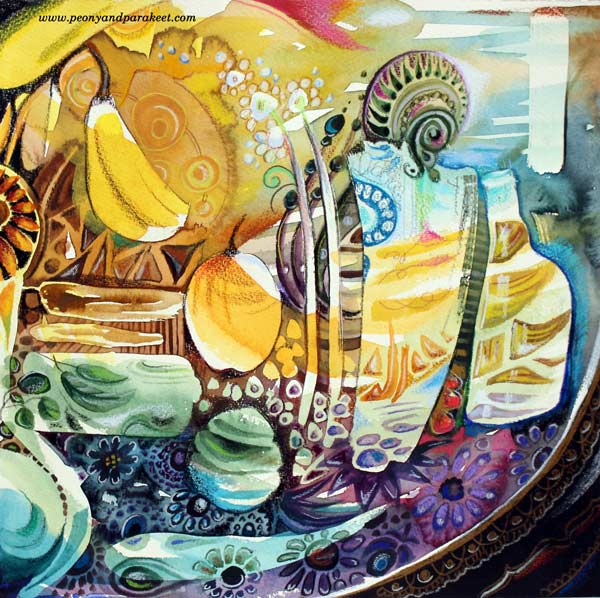
This artwork is inspired by the subject that keeps on fascinating me: beautiful objects like Russian handpainted plates! My admiration for them began many years ago, and only got stronger when I saw them in 2013 at St. Petersburg, Russia.
Here’s a scrapbook page which I made back then. My husband took the snapshot in The Russian Museum. Even if I look a bit worn out from the amount of walking we did during our travel, I love how my clothing and the plate match up!
We also bought one plate as a souvenir. I placed it on the table near me while finishing the painting. Just to keep me inspired to fine-tune all the details. But let’s not go that far yet! Before that, a lot happened, in my mind at least!

From Photos to Mental Images
Before starting the painting, I spent quite a lot of time thinking what to paint and how. I feel that it is easiest to think while walking, so I took the dogs out to the snowy nature. Then I took some photos, which is also a great way to observe and examine things.

After my beagles had fallen asleep, I browsed the photos. “There’s a difference of how I those subjects in my mind,” I thought. If I think of a Russian plate, I might see one detail of it, then other images come to the mind, then the fraction of a Russian plate again. The thoughts move so quickly that the images seem to get mixed up and change.
I could not help looking up what psychology says about it. Yes, there’s a concept called mental image and several theories about how mental images are formed in the mind.
What I find fascinating is, that when creating art, we tend to pick one photographic image instead of a mental image. Then we get disappointed when the artwork does not represent the realistic, photographic image. Replicating the photographic image to the mental image is extremely hard. Let’s try! Look at any of the photos above, then close your eyes and imagine every little detail of the image – impossible! Similarly, if you read a story for the first time, then try to repeat it exactly from word to word, you will certainly fail! But could we paint what we remember and see in our minds, like Edward Munch said: “I painted only memories, adding nothing, no details that I did not see.”
Using Mental Images in Art
I thought it would be both philosophically and practically interesting to use the mental image as a starting point for a painting. So, I decided to paint the mental image of my souvenir, the decorated plate. I forcefully thought about the plate for few minutes. But at the same time (as focusing on one thought is so dull), I was also cleaning. When I grabbed the morning newspaper to put it away, I saw an article of Paul Gauguin‘s artwork being sold at a high price. Just when I had gathered my thoughts around the Russian plates, there it was, a picture of Gauguin’s art! Whoosh … my mental image changed to a mixture of a decorative plate and Gauguin’s art, not just that specific one but many others too that I have seen!
While walking towards the room where I create art, I saw a banana on the kitchen counter, then thought about the wine we are going to taste to celebrate my coming birthday. My mind wondered towards glass objects – how I love them and how I should really paint only them … Before I began painting, my mental image had grown into a huge collage!
The complex thing in mental images is, that if you think very visually, holding the static view is difficult. Instead of trying to focus on one thing only, let it go and replace it with a more general subject. I chose my love for decorative art, beautiful concrete things and how they are at their best when they represent the beautiful shapes and shades from nature.
Instead of trying to build one controlled mental image first, accept the short-term, fractional nature of them. My artwork could be a collection of mental images appearing while I work. To emphasize that, I decided to start the painting with masking fluid. That way I could not even start building one complete image.
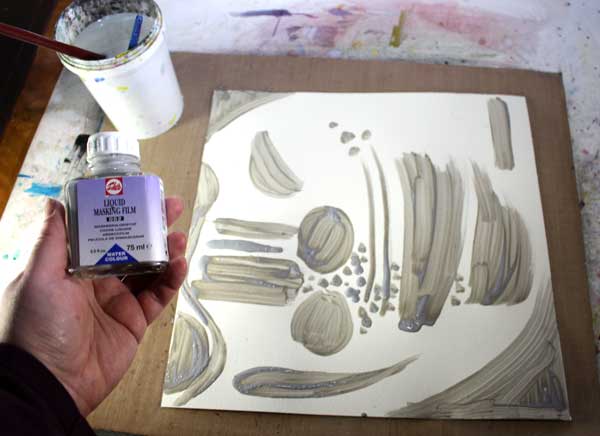
Masking Fluid
… or liquid masking film as my bottle says creates a rubber-like surface which you can remove afterward. You can add as many layers of paint as you like, then remove the masking fluid and you still have white areas to fill – or you can pick a colored area which you want to preserve and cover it with the fluid. It is a great way to obtain a layered look without too much thinking. Just remember to let the fluid dry properly before moving forward.
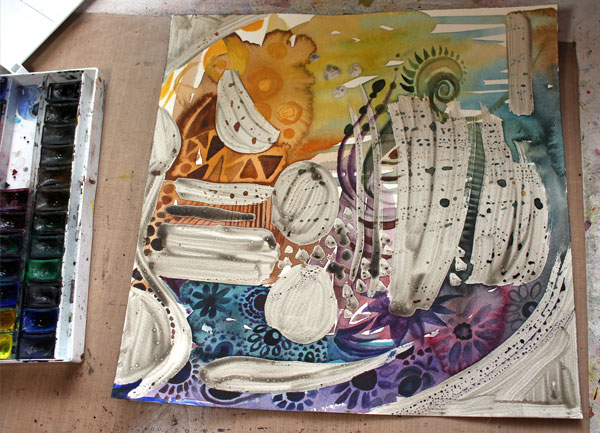
You can remove the dried fluid easily just by pulling it off with your fingers. With the help of the fluid, I was able to create very detailed areas before focusing on bigger objects so that they still look very sharp.
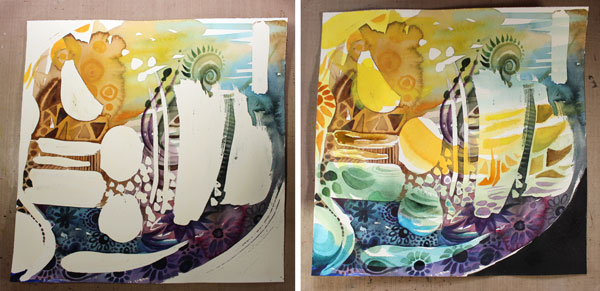
The painting was finished with colored pencils. The process was very similar to the one I teach in the video “Watercolor 101 for Intuitive Painting“, I just added the masking fluid before starting to paint with watercolors.
Here are some details of the finished piece:
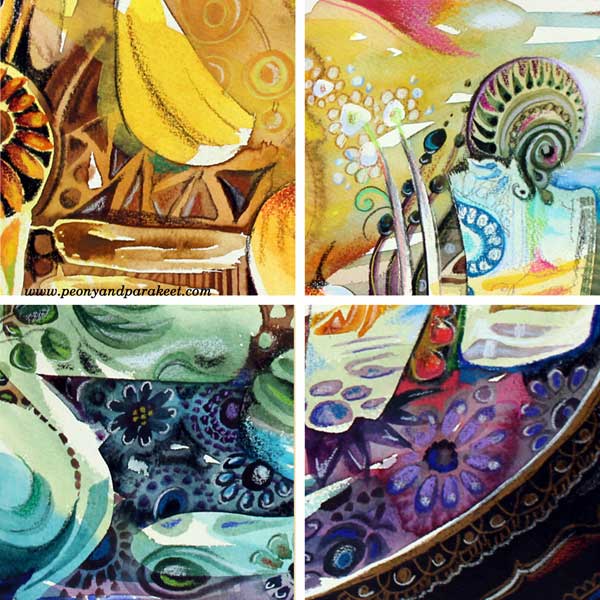
And here’s the painting again:
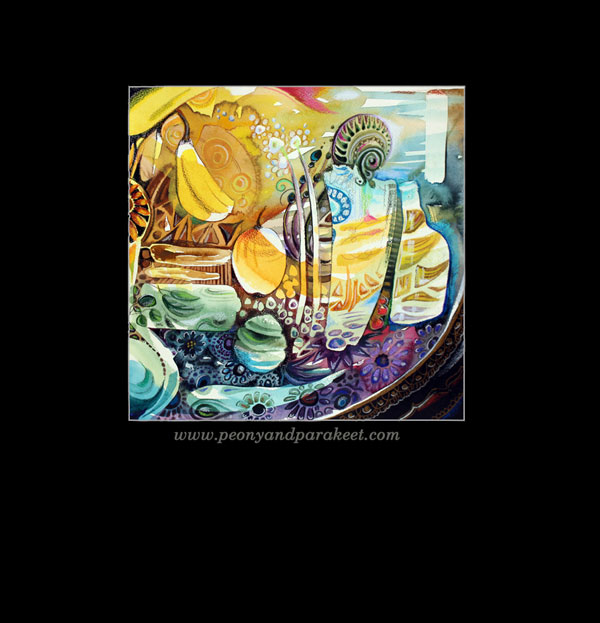
Before finishing, I realized that the banana from the kitchen counter had made it’s way to the painting. It seemed awkward at first but then, why not accept it to be the part of this surrealistic still life, surprisingly exact copy of the collection of my mental images!
What do you think? Could increasing intuition and including mental images improve your art?
Combine ideas with techniques – Buy Imagine Monthly Art Journaling Bundle!
13 thoughts on “Paint Your Mental Images!”
Comments are closed.
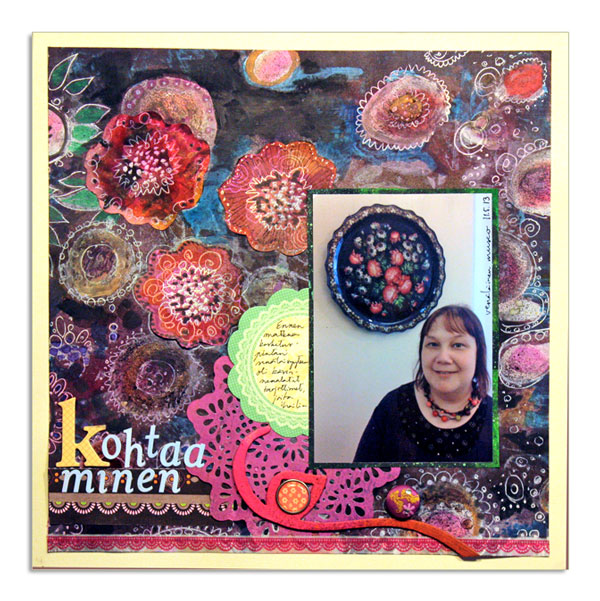
I love this piece! Thank you for explaining mental images. I have often admired the work of Canadian artist, Grant Leier, and this helps me to better understand his paintings. Your intuitive painting video has been very helpful to me. Thank-you Paivi!
Thanks, Linda! I searched for the artist, and: very rich, interesting paintings, somehow Frida Kahlo came to my mind. Thank you for mentioning the artist, it is great to examine new, interesting art!
Fascinating post today – your painting is lovely but when I look, my mind takes a different journey. I go under the sea and view it from a fish perspective. I live near the Gulf of Mexico and years ago when shipping vessels came to port, they used glass bottles for ballast-threw them into the sea-then loaded up what cargo they would take back to Europe. Many people have spent hours walking along the coast with a stick to poke into the sand and hear the “clink” then uncover the glass bottle. They all had round bottoms to store laying down which is how you can tell they were ballast bottles. Later, restaurants would dump their broken plates into the rocky surf that the buildings were built over. I see those with the fish swimming by, enjoying the play of sunshine on all the glass castoffs. Even a recently tossed banana! LOL Your painting brought back many of my own personal images to enjoy this morning. Thank you for sharing and for your lessons. You are a treasure, also!
Thanks, Mary! Great comment, it was interesting to read what you saw in the painting!
My imagination saw doorways, places to walk into and find different realities. Many stories could be told .Very beautiful work.
Thank you, Nea! Interesting to hear!
I have wanted to add decorative painting into my mixed media artwork for a long time but didn’t know how. My mom and grandma were from Norway and did rosemaling painting. I have so many decorative things around my house from them and I’m going to try your technique. Your watercolor class has helped me to break away from traditional styles and add markers, colored pencils etc. It’s very freeing. Thank you for the inspiration Paivi!
Thanks, Cathy! Great to hear that you ahve enjoyed the watercolor 101 class! I love decorative arts but I also think it can be used as self-expression, not just creating something pretty. Have fun!
Thank you so much for sharing the step-by-steps with us! I learn something new every time I read your blog.
Thank you, Peggy!!
Very nice! As always wonderful insights into creativity, thank you.
Thanks, Dianne!
I enjoyed this lesson! And was surprised to realize that I see a monkey (a monkey looking at a table set for a party). The banana makes the mouth with the black stem curving over the top of an ear. There is a nose and 2 eyes wearing wire-rimmed glasses atop the banana. It makes me smile.